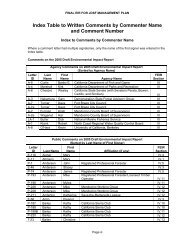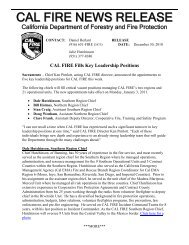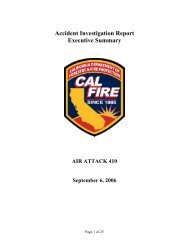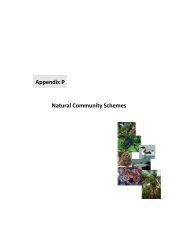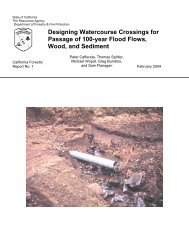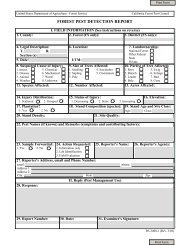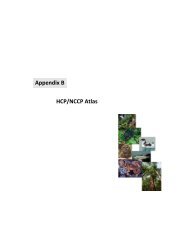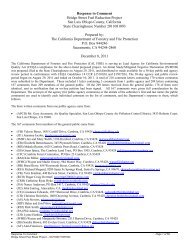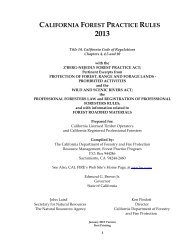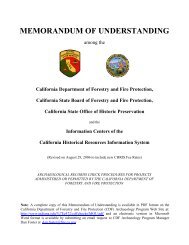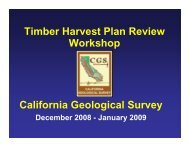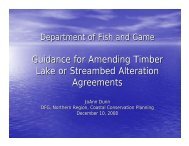Boggs Mountain Demonstration State Forest Draft ... - Cal Fire
Boggs Mountain Demonstration State Forest Draft ... - Cal Fire
Boggs Mountain Demonstration State Forest Draft ... - Cal Fire
You also want an ePaper? Increase the reach of your titles
YUMPU automatically turns print PDFs into web optimized ePapers that Google loves.
<strong>Boggs</strong> <strong>Mountain</strong> <strong>Demonstration</strong> <strong>State</strong> <strong>Forest</strong> <strong>Draft</strong> Management Plan, June 2008<br />
Work Site Descriptions<br />
ROAD 100<br />
Mileage begins at the junction of Road 300(west) and proceeds eastward<br />
Site1: Mile 0.0 to 0.5 (2640 ft.)<br />
Priority: High<br />
This section of road is insloped with an outside berm and an inboard ditch. The most significant<br />
problems are the serious erosion that is occurring with the inboard ditch and surface erosion of<br />
the roadbed. Drainage structures from Road 300, which is upslope approximately 100-200 feet,<br />
are having a significant impact on the amount of concentrated runoff accumulating on this section<br />
of Road 100. As a result, the ditch relief culverts are overwhelmed and are highly susceptible to<br />
plugging. In some places the inboard ditch has eroded to 5 feet wide and 6 feet deep, while in<br />
other downslope locations, the inboard ditch has filled with fine sediment and is non-existent. The<br />
headwall for the culverts, in some cases, is non-existent or is badly degraded. The berm on the<br />
outside road edge channels surface runoff back onto the roadbed. Even where the road surface<br />
is level, crowned or slightly outsloped, the outside berm prevents free-flow drainage of the road<br />
surface. There are several waterbars that drain surface runoff, but the main problem is with the<br />
inboard ditch. Most of the sediment yield is dissipated on the downhill slopes, but a fair<br />
percentage is delivered to Mill Creek. Parent rock exposed first .05 miles of road and then at .15,<br />
.5-.7 miles. Inboard ditch is filled in and the berm deteriorating in some spots. Runoff flows<br />
downhill from culvert #4.<br />
Remedial treatments include:<br />
1. Outslope road surface<br />
2. Remove ditch relief culverts and replace with rolling dips or rocked fords<br />
3. Excavate outside berm and use spoil to fill inboard ditch<br />
4. Upgrade culvert #2 to 18” diameter or install rocked ford and armor outfall<br />
5. Retain inboard ditch, mile 0.7 to 0.75<br />
Site 2: Mile 0.75<br />
Priority: High<br />
Mill Creek Stream Crossing<br />
There are currently two 30” diameter culverts at this stream crossing with a headwall of approx. 5<br />
feet. A waterbar drains the overflow but does not direct the runoff back into the watercourse (High<br />
Diversion potential). Slope erosion into inboard ditch just past Mill Creek.<br />
Remedial treatments include:<br />
1. Replace and install larger culvert (diameter 72”, length 40 feet)<br />
2. Install Pipe Arch culvert (72” diam.)<br />
3. Increase headwall height<br />
4. Maintain vegetation control at inlet<br />
5. Install Trash Rack to prevent debris from plugging culverts<br />
6. Install Critical dip<br />
Site 3: Mile 0.75 to 1.2 (2376 ft.)<br />
This section of road is insloped with an outside berm and an inboard ditch. The berm on the<br />
outside road edge channels surface runoff back onto the roadbed. There are several waterbars<br />
that drain surface runoff, but the main problem is with the inboard ditch. The inboard ditch has<br />
62



